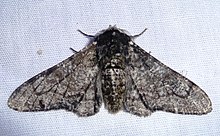Peppered Moth
| Peppered moth | |
|---|---|
 |
|
| male | |
|
Not evaluated (IUCN 3.1)
|
|
| Scientific classification | |
| Kingdom: | Animalia |
| Phylum: | Arthropoda |
| Class: | Insecta |
| Order: | Lepidoptera |
| Family: | Geometridae |
| Genus: | Biston |
| Species: | B. betularia |
| Binomial name | |
|
Biston betularia Linnaeus, 1758 |
|
| Subspecies | |
|
|
| Synonyms | |
|
|
The peppered moth (Biston betularia) is a temperate species of night-flying moth.Peppered moth evolution is an example of population genetics and natural selection.
The wingspan is 55mm. median (45–62 mm.) It is relatively stout-bodied, with forewings relatively narrow-elongate. The wings are white, "peppered" with black, and with more or less distinct cross lines, also black. The black speckling varies in amount, in some examples it is almost absent, whilst in others it is so dense that the wings appear to be black sprinkled with white. The antennae of males are strongly bipectinate.
Biston betularia is found in China (Heilongjiang, Jilin, Inner Mongolia, Beijing, Hebei, Shanxi, Shandong, Henan, Shaanxi, Ningxia, Gansu, Qinghai, Xinjiang, Fujian, Sichuan, Yunnan, Tibet), Russia, Mongolia, Japan, North Korea, South Korea, Nepal, Kazakhstan, Kirghizstan, Turkmenistan, Georgia, Azerbaijan, Armenia, Europe and North America.
In Great Britain and Ireland, the peppered moth is univoltine (i.e., it has one generation per year), whilst in south-eastern North America it is bivoltine (two generations per year). The lepidopteran life cycle consists of four stages: ova (eggs), several larval instars (caterpillars), pupae, which overwinter live in the soil, and imagines (adults). During the day, the moths typically rest on trees, where they are preyed on by birds.
...
Wikipedia
